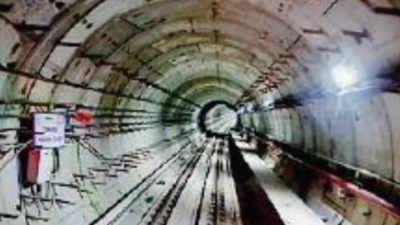- News
- City News
- kolkata News
- Kolkata-Howrah metro line to have India’s deepest evacuation shaft
Trending
Kolkata-Howrah metro line to have India’s deepest evacuation shaft
India's first under-river tunnel, the East-West Metro in Kolkata, features the country's deepest ventilation-evacuation shaft. Passengers will have to climb the 273 steps of the shaft for evacuation in case of an under-river crisis. The project is being implemented by Kolkata Metro Rail Corporation (KMRC).

Metro trial run under the river Ganga
KOLKATA: Apart from being India’s first under-river tunnel, the upcoming East-West Metro stretch linking Kolkata with Howrah will feature another engineering marvel.
It will have the country’s deepest ventilation-evacuation shaft, which equals a 15-storey building. Passengers would have to climb the entire height (273 steps) of the shaft, which has been built near the Brabourne Road flyover, to be evacuated out.Installation of electricity-run elevators was avoided keeping the safety factor in mind.
East-West Metro’s truncated Esplanade-Howrah Maidan section is ready for commissioning. Tunnels and three of the four stations dotting the 4.8km stretch were structurally completed in 2019. The 43.5m deep ventilation-cum-evacuation shaft was completed in Aug 2020.

At Howrah Metro station, the 520m twin tunnels plunge 30m into the river. From there, they go deeper till 37m, crossing the riverbed. The shaft had to go as deep as 43.5m. “It has been built with innovative engineering techniques to navigate geological challenges and overcome any impact on the Circular Railway line that runs along the riverbank,” an engineer of Kolkata Metro Rail Corporation (KMRC), the implementing agency of the 16km East-West Metro, said. The corridor, also known as the Green Line, now runs 9.2km from Sector V to Sealdah. It will eventually have a continuous link to Howrah Maidan.
“Considering utmost passenger safety in critical conditions like fire or smoke, when people will have to be evacuated from the tunnel, lifts, which run by electricity, were skipped,” said Biswas. In all, 273 steps are to be climbed. The staircase is split into 23 landings.
“The National Fire Protection Association (NFPA) guidelines make evacuation shafts mandatory if the distance between two stations exceeds 762m. Alternatively, cross passages can be built every 244m. The latter wasn’t possible under the river. So we ended up building India’s deepest ventilation shaft, which is deeper than the usual 16m-20m ones constructed so far,” Biswas said. There were challenges galore. Afcons encountered two aquifers in the river that posed risks of water ingress.
It will have the country’s deepest ventilation-evacuation shaft, which equals a 15-storey building. Passengers would have to climb the entire height (273 steps) of the shaft, which has been built near the Brabourne Road flyover, to be evacuated out.Installation of electricity-run elevators was avoided keeping the safety factor in mind.
East-West Metro’s truncated Esplanade-Howrah Maidan section is ready for commissioning. Tunnels and three of the four stations dotting the 4.8km stretch were structurally completed in 2019. The 43.5m deep ventilation-cum-evacuation shaft was completed in Aug 2020.

“The shaft will not only provide ventilation (by pumping in air into the river tunnels), it will play the crucial role during evacuation,” said Tamal Biswas, project manager of Afcons, contractor for the 3.8km Howrah Maidan-Esplanade stretch, including the 520m-long under-river tunnels.
At Howrah Metro station, the 520m twin tunnels plunge 30m into the river. From there, they go deeper till 37m, crossing the riverbed. The shaft had to go as deep as 43.5m. “It has been built with innovative engineering techniques to navigate geological challenges and overcome any impact on the Circular Railway line that runs along the riverbank,” an engineer of Kolkata Metro Rail Corporation (KMRC), the implementing agency of the 16km East-West Metro, said. The corridor, also known as the Green Line, now runs 9.2km from Sector V to Sealdah. It will eventually have a continuous link to Howrah Maidan.
“Considering utmost passenger safety in critical conditions like fire or smoke, when people will have to be evacuated from the tunnel, lifts, which run by electricity, were skipped,” said Biswas. In all, 273 steps are to be climbed. The staircase is split into 23 landings.
“The National Fire Protection Association (NFPA) guidelines make evacuation shafts mandatory if the distance between two stations exceeds 762m. Alternatively, cross passages can be built every 244m. The latter wasn’t possible under the river. So we ended up building India’s deepest ventilation shaft, which is deeper than the usual 16m-20m ones constructed so far,” Biswas said. There were challenges galore. Afcons encountered two aquifers in the river that posed risks of water ingress.
End of Article
FOLLOW US ON SOCIAL MEDIA










